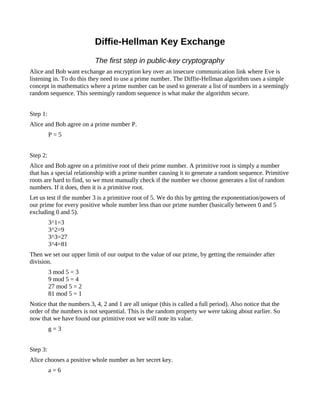Diffie-Hellman key exchange
•
4 j'aime•12,303 vues
The Diffie-Hellman key exchange algorithm allows Alice and Bob to securely exchange an encryption key over an insecure communication channel where Eve may be listening. It works by first agreeing on a prime number and primitive root. Then, Alice and Bob each generate a public key by raising the primitive root to the power of their private key and taking the result modulo the prime number. They exchange public keys. Finally, each computes a shared secret key by raising the other's public key to the power of their private key and taking the result modulo the prime number, arriving at the same shared key without having transmitted the private keys.
Signaler
Partager
Signaler
Partager
Télécharger pour lire hors ligne

Recommandé
Recommandé
Contenu connexe
Tendances
Tendances (20)
Syntax-Directed Translation into Three Address Code

Syntax-Directed Translation into Three Address Code
Elliptic curve Cryptography and Diffie- Hellman Key exchange

Elliptic curve Cryptography and Diffie- Hellman Key exchange
RSA - ALGORITHM by Muthugomathy and Meenakshi Shetti of GIT COLLEGE 

RSA - ALGORITHM by Muthugomathy and Meenakshi Shetti of GIT COLLEGE
Implementation of RSA Algorithm for Speech Data Encryption and Decryption

Implementation of RSA Algorithm for Speech Data Encryption and Decryption
Design And Implementation Of Tiny Encryption Algorithm

Design And Implementation Of Tiny Encryption Algorithm
En vedette
En vedette (6)
Similaire à Diffie-Hellman key exchange
Similaire à Diffie-Hellman key exchange (6)
Cryptography-Diffie Hellman Key Exchange Algorithm.pptx

Cryptography-Diffie Hellman Key Exchange Algorithm.pptx
Plus de hughpearse
Plus de hughpearse (8)
Diffie-Hellman key exchange
- 1. Diffie-Hellman Key Exchange The first step in public-key cryptography Alice and Bob want exchange an encryption key over an insecure communication link where Eve is listening in. To do this they need to use a prime number. The Diffie-Hellman algorithm uses a simple concept in mathematics where a prime number can be used to generate a list of numbers in a seemingly random sequence. This seemingly random sequence is what make the algorithm secure. Step 1: Alice and Bob agree on a prime number P. P=5 Step 2: Alice and Bob agree on a primitive root of their prime number. A primitive root is simply a number that has a special relationship with a prime number causing it to generate a random sequence. Primitive roots are hard to find, so we must manually check if the number we choose generates a list of random numbers. If it does, then it is a primitive root. Let us test if the number 3 is a primitive root of 5. We do this by getting the exponentiation/powers of our prime for every positive whole number less than our prime number (basically between 0 and 5 excluding 0 and 5). 3^1=3 3^2=9 3^3=27 3^4=81 Then we set our upper limit of our output to the value of our prime, by getting the remainder after division. 3 mod 5 = 3 9 mod 5 = 4 27 mod 5 = 2 81 mod 5 = 1 Notice that the numbers 3, 4, 2 and 1 are all unique (this is called a full period). Also notice that the order of the numbers is not sequential. This is the random property we were taking about earlier. So now that we have found our primitive root we will note its value. g=3 Step 3: Alice chooses a positive whole number as her secret key. a=6
- 2. Step 4: Alice computes her public key and sends it to Bob. A = g^a mod P or 4 = 3^6 mod 5 A=4 Note: This formula is the same one we used earlier to find our primitive root and we are using the same values for g and P. This means that whatever number Alice chose for her private key, the output will be one of the random numbers from our list. This randomness is very important. Step 5: Bob chooses a positive whole number as his secret key. b=7 Step 6: Bob computer his public key and sends it to Alice. B = g^b mod P or 2 = 3^7 mod 5 B=2 Step 7: Alice and Bob now compute a shared secret key [Shared Key] = [other persons public key]^[their own secret key] mod P Bob: S = 4^7 mod 5 Alice: S = 2^6 mod 5 S=4 Conclusion: “P”, “g”, “A” and “B” were transmitted. Can “a” and “b” be calculated? Hint: discrete logarithm.